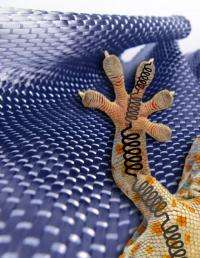New gecko insights inspire even stronger adhesives

At first glance, a gecko skittering up a wall and a flat-screen television attached to the same wall have little in common.
But researchers at the University of Massachusetts Amherst have made the connection.
First they showed the previously unappreciated role of geckos' tendons and bones in the little lizards' ability to climb up walls without slipping. Then they used that knowledge -- plus a large helping of human ingenuity -- to create an adhesive device that can hold the television securely on a wall.
"Our 'Geckskin' device is about the size of an index card and can hold a maximum force of about 700 pounds while adhering to a smooth surface such as glass," said Alfred Crosby, associate professor of polymer science and engineering at the University of Massachusetts Amherst.
To produce it, Crosby added, "We focused on the properties and attributes of the gecko: high capacity, easy release, reliability, and the ability to stick to a variety of surfaces."
"This is definitely an important contribution," said Metin Sitti, professor of mechanical engineering at Carnegie Mellon University and an expert on small-scale locomotion and manipulation, who did not participate in the project.
Crosby carried out the research with his doctoral candidate Michael Bartlett and biology professor Duncan Irschick, with support from the Pentagon's Defense Advanced Projects Research Agency.
Scientists have long recognized that so-called van der Waals forces, which produce weak electrical attraction among molecules, cause adhesion between tiny hairs in geckos' toes, known as setae, and vertical surfaces on which the geckos climb.
However, efforts to apply that process on a large scale have had limited success. Scotch tape gains its stickiness through the van der Waals forces.
"But you can't make the forces stronger," Crosby said. "People have tried to produce artificial setae," Irschick added. "But they don't scale up effectively."
To develop a different approach, the UMass team studied the large-scale structure of geckos' feet.
Expanding on research by University of Calgary biologist Anthony Russell, the team discovered how tendons, bones, and skin work together to produce the easily reversible adhesion that causes a gecko's feet to stick to a wall briefly and then release from it as the tiny lizard moves up, down, or sideways on the wall. The process works in large part because of the role of the tendons. In most creatures, tendons connect bones to muscles.
"But in geckos' feet, uniquely, the tendons stretch from bone into skin," Irschick explained.
The group used that knowledge as the basis of an adhesive system stronger than any relying on van der Waals forces.
"We wanted something that would cover a large area and would become increasingly stiff," Crosby recalled. "But those demands are contradictory."
Scotch tape, for example, covers a large area, but is soft and thus unable to hold significant weight. The geckos' anatomy suggested that the team could overcome the contradiction by using a specially treated fabric. A fabric can be both soft and stiff. A tablecloth, for instance, can drape over a table and conform to the shape of anything underneath it while remaining stiff if you try to pull it. For their Geckskin, the researchers mimicked the anatomy of geckos' feet.
"We took a fabric, put a bit of rubber around it, and sewed another piece of fabric -- the 'tendon' -- into that 'skin'," Crosby explained.
Since the fabric is stiff and the rubber soft, the combination yields a stiff but flexible system that drapes over a large surface area, permitting maximum contact and adhesion.
Geckskin's strength does not apply in all directions. While it is almost impossible to move it along any surface on which it is mounted, Crosby said, "a gentle peel from one edge allows it to be effortlessly removed from the surface on command."
It can be removed and stuck onto another surface as often as needed without leaving any residue or losing adhesive strength.
The team has used a variety of ingredients for the rubber component. In particular polydimethylsiloxane, a component of silly putty, holds the promise, in combination with fabric, of developing an inexpensive, strong, and durable dry adhesive.
The researchers also tried a variety of fabrics.
"Those with the greatest load capacity use the fibers such as Kevlar and fiber-based fabrics that are most stiff," Crosby said.
According to Crosby, Geckskin stacks up well against current commercial adhesives.
"The force per area is definitely higher than all the pressure-sensitive adhesives," Crosby said. "The combination of high force and user release is not there in available adhesive systems. And unlike Velcro, Geckskin doesn't need a matching surface."
The team, which reported its advance in the journal Advanced Materials, is now discussing possible commercialization of the technology.
Source: Inside Science News Service




















